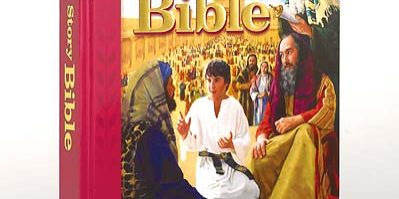
The Best Children’s Bible You’ve Never Heard Of (Timothy Raymond )
As the father of four young children, and as someone deeply committed to regular family Bible reading and prayer, I’m constantly on the lookout for good children’s Bibles for reading aloud to my kids. I’ve either read through or am sufficiently familiar with all of the standard ones currently popular among gospel-centered, confessional evangelicals. In the last year, however, I’ve discovered another children’s Bible which, though not as widely known, really ought to be at the top of the list. It’s entitled The Story Bible, published by our friends at Concordia Publishing House, and let me tell you why this has become the gold-standard for our family Bible reading.
First and foremost, what I absolutely love about this children’s Bible is that the text is actual Bible text and not somebody’s paraphrase. From time to time, when reading one of the other children’s Bibles which retell biblical stories, I found myself disagreeing with the interpretation underlying the paraphrase. I felt uncomfortable reading things to my kids that I didn’t actually think were true (or would try to edit on the fly). You won’t have that problem with this Bible. About 90% of text of The Story Bible is a simplified form of the English Standard Version (about 60% Old Testament, 40% New Testament), geared for children ages 3 to 8. Very occasionally a non-inspired paragraph or sentence is inserted for clarity, but most of the time, your kids will actually be listening to God speak through His Word. And because it follows the ESV so closely, The Story Bible should help a child to transition easily to the English Standard Version (or another commonly used version) within a few years.
A second reason our family loves this Bible is the beautiful, realistic, and theologically-accurate artwork accompanying each biblical account. Hands down, The Story Bible contains artwork that’s far better than any other children’s Bible out there. You’ve really got to see the paintings to believe me. Moreover, the paintings teach biblical truth in a visual form. There’s a dinosaur in the Garden of Eden; Noah’s Ark is of the size and dimensions that the biblical text demands; Herod’s Temple looks just like what the Temple must have looked like in Jesus’ day. And very helpfully, the pictures keep my kids mesmerized while I’m reading the text to them.
Finally, we love The Story Bible because of the suggested activities accompanying all 130 biblical accounts. It’s obvious that this Bible was put together in consultation with specialists in child education. Each story includes 2-4 reading comprehension questions, a simple children’s prayer based on the truth taught in the text, and an action-lesson (e.g., a craft, skit, activity, etc.) designed to reinforce the reading. Our family generally skips the action-lessons, but my kids love the comprehension questions and prayers. Maybe best of all, the prayers teach children how to pray back Scripture to God.
Now, realizing that I absolutely love The Story Bible, here are three quick caveats you might appreciate knowing. First, it’s a surprisingly large and heavy children’s Bible. While it’s made with great quality (like all the resources I’ve used by CPH), at 10” by 9” by 1¼”, with a hardcover and thick, glossy paper, I’d guess it weighs 8-10 pounds. This isn’t much of a problem, unless you have your kids bring the Bible to reading time and they have a tendency to drop it. A few of the corners on ours are busted up.
Second, like nearly all children’s Bibles, The Story Bible includes copious pictorial depictions of Jesus. While these are all well-done, historically-accurate (even ethnically-accurate), and modest, if you’re in a theological tradition that interprets the Second Commandment as prohibiting all drawings of Jesus, including those not intended for worship, this may not be a Bible with which you’re comfortable.
Third, and perhaps most significantly, The Story Bible does subtly reflect the theological emphases of the Lutheran Church Missouri Synod (LCMS). Now if you’re not familiar with the LCMS, they’re the Lutherans who believe in the inerrancy of the Bible, justification by faith alone, and actually follow what Martin Luther preached and taught (an interesting intro by Kevin DeYoung is here). Their doctrinal distinctives are often very insightful and helpful, but if you’re, say, a Baptist, Presbyterian, Anglican, or Methodist by conviction, this Bible will cause you to raise an eyebrow every once in a while. But again, these are very occasional and subtle, and as a Baptist pastor, I have no reservations giving The Story Bible my highest recommendation.
Timothy Raymond is an editor for Credo Magazine and has been the pastor of Trinity Baptist Church in Muncie, Indiana since April 2006. He received his MDiv from the Baptist Bible Seminary of Pennsylvania in 2004 and has pursued further education through the Christian Counseling and Educational Foundation. Tim grew up outside Syracuse, NY and previously served at Berean Baptist Church, Nicholson, PA (member and teacher during college and seminary) and Calvary Baptist Church, Sandusky, Ohio (seminary internship location). Tim met his wife Bethany at college, and they were married in May 2001. Tim enjoys reading, weight-lifting, wrestling with his three sons, and attempting to sleep.

